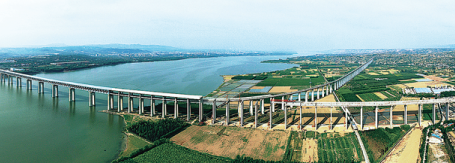Transport network boosts Shanxi's reach

The bridge over the Yellow River between the Shanxi city of Yuncheng and Sanmenxia in Henan province is a major connectivity project. [Photo by Sun Rongxiang for China Daily]
Recognizing its role in promoting economic development, the North China province of Shanxi has made great strides in developing its transport network over the past decades, aiming to facilitate people's travel and flow of goods.
Shanxi began to develop a modern transport network in the late Qing Dynasty (1644-1911), starting from building railways.
But it is since the founding of the People's Republic of China in 1949 that Shanxi has developed a comprehensive transport network that covers highways, railways and civil aviation.
The transport industry was given a stronger boost nearly three decades ago, when Shanxi began to build its first expressway in 1993. Today, the province has more than 5,760 kilometers of expressways. And the construction of expressways has not stopped here. Several projects, including lines to link cities inside the province and connecting to the rest of the country, are under construction this year and more are planned for the future.
While cities in Shanxi are well connected with highways, expressways and railways, the expansive rural regions are not left behind.
Shanxi's investment in rural roads reached its peak during the 13th Five-Year Plan (2016-20). The province had channeled more than 100 billion yuan ($14.9 billion) into building 78,400 km of rural roads during the period. As a result, the current rural road network, with a total length of 126,000 km, has put all the villages in Shanxi on wheels.
Shanxi entered the high-speed train era more than a decade ago, when its first high-speed railway to link the Shanxi provincial capital of Taiyuan with Shijiazhuang, the provincial capital of neighboring Hebei, began operations in April 2009. Today, its high-speed railways totaled 1,150 km, connecting all nine large cities in the province.
While the high-speed lines are mainly used for passengers, the bulk of its conventional lines, with a combined length surpassing 5,000 km, are devoted to both passenger and freight transportation.
Shanxi is now also playing a leading role in China's civil aviation. It has the densest air routes of any province in China.
While the province's major cities are linked with 82 destinations in China and overseas with 278 air routes, intercity air transportation inside Shanxi has seen rapid development over the past three years thanks to the medium and short-distance lines operated by general aviation companies. And the short-haul routes are the major reason for the province's highest air-route density.
Over the past three years, Shanxi General Aviation Group, the leading general aviation operator in Shanxi, for instance, has opened seven short-distance routes linking cities in Shanxi, and two routes to connect to cities in neighboring provinces.
Han Linfang contributed to this story.


